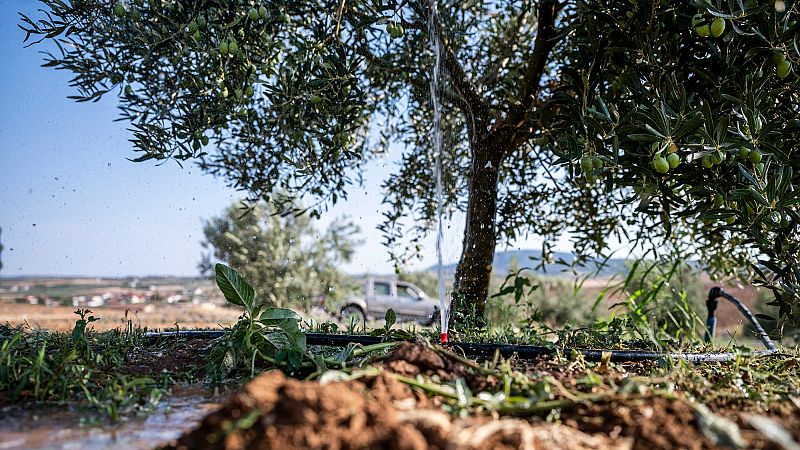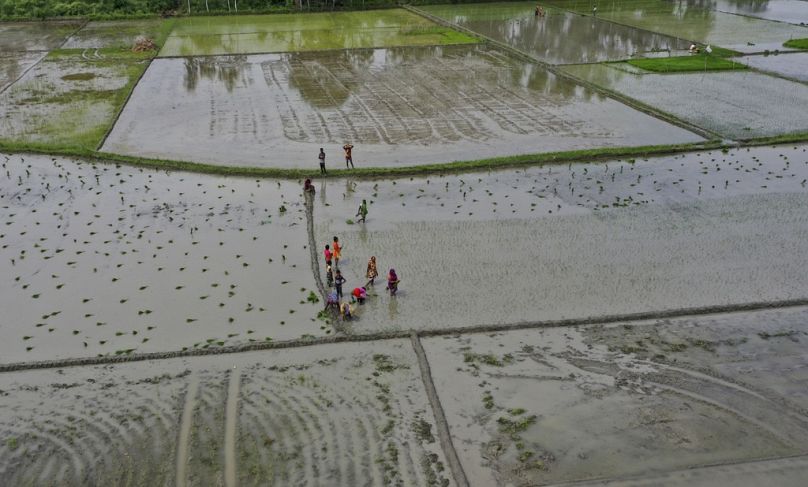
Food prices in Europe and around the world have risen sharply in recent years, in a worrying trend for consumers.
While higher production costs and the war in Ukraine have fuelled some of the price hikes, extreme weather events have also played a significant role, according to new research.
A study published on Monday highlighted 16 food items across 18 countries - including British potatoes and Spanish olive oil - that have become more expensive as a result of unprecedented heat, drought or rainfall between 2022 and 2024.
Its authors say these examples highlight the ongoing societal risks posed by the impacts of unmitigated climate change on the food system.
“Until we get to net-zero emissions, extreme weather will only get worse, and it's already damaging crops and pushing up the price of food all over the world,” says Maximillian Kotz, Marie-Curie post-doctoral fellow at BSC and lead author of the study.
Heat, drought and rain drive spikes in food prices
Recent years have seen numerous abnormal weather events that would have been unprecedented prior to 2020.
2024 was the hottest year on record, with global temperatures exceeding 15°C above preindustrial climate conditions for the first time and records broken across large parts of Earth’s surface.
Heavy rain lashed the UK between September and December 2023, while areas of Pakistan and Australia suffered disastrous floods in 2022.
The new study, published in Environmental Research Letters, has now linked these extreme weather phenomena to spikes in food prices.
The research was conducted by an interdisciplinary team from six European research institutes, including the Barcelona Supercomputing Centre, Postdam Institute for Climate Impact Research, Catalan Institution for Research and Advanced Studies (ICREA), the Energy & Climate Intelligence Unit (ECIU) and University of Aberdeen and the Food Foundation, alongside the European Central Bank (ECB).
It was released ahead of the United Nations Food Systems Summit, which will be co-hosted by Ethiopia and Italy in Addis Ababa, Ethiopia, from 27 to 29 July.
Climate change is making British potatoes and Spanish olive oil more expensive
The study investigated examples of food price spikes associated with heat, drought and heavy rain across 18 countries over a two-year period from 2022 to 2024.
Extreme weather phenomena can destroy growing crops and severely impact yields.
Two European food items were included in the research. In the UK, potato prices increased 22 per cent from January to February 2024 due to extreme winter rainfall.
“Last year, the UK had its third-worst arable harvest on record, and England its second worst, following extreme rainfall that scientists said was made about 10 times more likely and 20 per cent more intense by climate change,” says Amber Sawyer, analyst at the UK’s ECIU.
“But it's not just that. British farmers have been yo-yoing between extremes for the past few years.”
Sawyer adds that they've gone from having to contend with extreme heat in 2022, when temperatures reached 40°C for the first time, to extreme rain in late 2023 and early 2024, both of which ruined their crops. And now, they've just faced the warmest spring since records began and the sixth driest.

“For them, climate change isn't a distant warning: it's a reality they're living every day.”
Across Italy and Spain, olive oil prices shot up 50 per cent year-on-year in January 2024 following severe drought in 2022 and 2023.
Hotter, drier weather saw olive oil production in Spain - which is responsible for 40 per cent of the world’s supply - fall by 50 per cent in 2022.
High temperatures in the spring blossoming season destroyed many olive trees, and the few surviving fruits grew small and thin because of the lack of water.
This May was the world’s second warmest ever recorded, exceeded only by May 2024, according to the EU’s Copernicus Climate Change Service (C3S).
Parts of northwestern Europe saw their lowest precipitation and soil moisture levels since at least 1979.
Farmers across northern Europe have voiced fears for their crops, with unusually dry weather delaying the sprouting of wheat and corn.
Extreme weather sees price spikes for rice, coffee and cocoa
Food production in other parts of the world has also been affected by extreme weather, with knock-on effects on domestic and global markets.
Heatwaves across East Asia during 2024 led to unprecedented monthly temperatures across virtually all of South Korea and Japan, as well as large parts of China and India.
Government statistics indicate that these events resulted in substantial increases in the price of Korean cabbage (70 per cent higher in September 2024 compared to September 2023) and Japanese rice (48 per cent higher in September 2024 compared to September 2023).
With California accounting for over 40 per cent of US vegetable production, unprecedented drought across California and Arizona in 2022 contributed to an 80 per cent year-on-year increase in US vegetable producer prices by November 2022.
Ghana and the Ivory Coast produce nearly 60 per cent of global cocoa.
Record monthly temperatures across the majority of both countries in February 2024, on top of a prolonged drought in the prior year, led to increases in global market prices of cocoa of around 300 per cent by April 2024 compared to the previous year.
Similar effects were observed for coffee following heatwaves and drought in Vietnam and Brazil in 2024.
Extreme weather threatens food security and public health
The study highlights how these climate-driven food price spikes can also aggravate public health risks and social unrest.
Rising food prices have direct implications for food security, particularly for low-income households.
“These effects can be strongly regressive given the substantial disparities in the share of income spent on food by low- and high-income households,” the researchers write.
“The fact that larger price increases occur in hotter and typically poorer countries will further amplify these effects.”
Furthermore, price increases shift consumer spending towards cheaper, often less nutritious options.
This means climate-induced price increases could exacerbate the health problems deriving from malnutrition and a range of chronic diet-related conditions, including coronary heart disease, type 2 diabetes and many cancers.
The scientists also note that food price inflation associated with climate extremes may come to bear increasing political relevance, with anecdotal evidence from across history often citing food price increases as a precursor to political unrest and social upheaval. The report suggests that high rates of inflation can even directly alter election outcomes in modern democracies.
“People are noticing, with rising food prices number two on the list of climate impacts they see in their lives, second only to extreme heat itself,” Kotz notes, adding that it was clear the cost of living had played a role in last year’s US election.
The price of food was listed as a key election issue during both the UK and US elections in 2024 and the elections in Argentina in 2023.
Urgent need for adaptation and resilience
The study concludes by urging the need for rapid adaptation and resilience to bolster food security.
It proposes seasonal to multi-annual climate predictions, which may offer farmers early warning of short-term exposure to climate extremes and their impact on yields.
“At the producer-level, timely information on climate conditions can enable optimisation of crop choices or scheduling to limit exposure and impacts,” the scientists write.
Agricultural adaptation strategies for the long term will also be vital, they say.
While crop switching and irrigation are widely discussed as a potential solution, challenges in their implementation have also been raised.
“This highlights the resource, economic and potentially political constraints which may often impede adaptation strategies, an area requiring careful consideration by research and policymakers to identify effective adaptation strategies,” the authors write.







